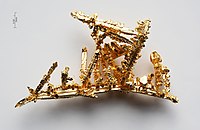
Photo from wikipedia
We describe a novel gold chloride complex supported by an ambiphilic phosphine/xanthylium ligand in which the AuCl moiety interacts with the π+ surface of the xanthylium unit as indicated by… Click to show full abstract
We describe a novel gold chloride complex supported by an ambiphilic phosphine/xanthylium ligand in which the AuCl moiety interacts with the π+ surface of the xanthylium unit as indicated by structural studies. Energy decomposition analyses carried out on a model system indicates the prevalence of non-covalent interactions in which the electrostatic and dispersion terms cumulatively dominate. The presence of these AuCl–π+ interactions correlates with the high catalytic activity of this complex in the cyclisation of 2-(phenylethynyl)phenylboronic acid, N-propargyl-t-butylamide, and 2-allyl-2-(2-propynyl)malonate. Comparison with the significantly less active acridinium and the 9-oxa-10-boraanthracene analogues reinforces this conclusion.
Journal Title: Chemical Science
Year Published: 2022
Link to full text (if available)
Share on Social Media: Sign Up to like & get
recommendations!